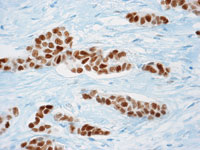

About two-thirds of all breast cancer cells are ER-positive, meaning the tumors contain significant levels of receptors for the female hormone estrogen. The other third of breast cancers, ER-negative cancer, tend to grow more aggressively; they are more likely to metastasize, and are associated with a worse prognosis. Researchers suspect that the higher proportion of ER-negative tumors found in African American breast cancer patients, compared with white patients, may contribute to the higher breast cancer mortality rates seen in the African American population. Research to improve outcomes for patients with ER-negative breast cancer is an important strategy for addressing this health disparity. NCI is supporting identification and exploration of the basic biologic attributes of ER-negative breast cancer, including molecular mechanisms that can be targeted with prevention, early detection, and treatment interventions.


Two-thirds of breast cancer cells express the estrogen receptor (top), and one third—which tend to grow more aggressively—do not (bottom).
NCI's commitment to research that improves the quality of cancer care is a theme that runs through all of the Institute's research. Indeed, we still have much to learn about why some fare better with cancer than others, why some racial and ethnic groups have higher incidences of cancer than others, and how to assist those who may lack language capacity, mobility, or even the knowledge to navigate our healthcare system.
Two community-based programs of note—the Community Networks Program and the Patient Navigator Program—are further proof of that commitment to all of our citizens.
The Community Networks Program (CNP), which began in May, 2005 as a follow-up to our successful Special Population Networks program, works toward the reduction of disparities in cancer care, prevention, and survivorship through community-based participatory education, training, and research among racial and ethnic minorities and underserved populations. To date, NCI has awarded $95 million in 5-year grants to 25 institutions located in regions of the United States where the cancer burden is disproportionately high. Most sites have formed clinical partnerships that provide prevention services, including tobacco cessation, diet and exercise programs, and screening services for breast, prostate, colorectal, and cervical cancer. More than 640 partnerships with major cancer collaborators, such as the American Cancer Society, Susan G. Komen For the Cure Foundation, the National Urban League, state and local health departments, clinics, and hospitals, as well as regional offices of NCI's Cancer Information Service, help to build a strong and sustainable community-based infrastructure.
NCI's Patient Navigation Research Program (PNRP) focuses on developing and testing interventions to promote cancer awareness within communities and to help patients and their families manage cancer diagnoses and overcome common barriers to obtaining timely and appropriate cancer care and treatment. The primary participants for this research program are those experiencing cancer health disparities, encompassing racial/ethnic minorities, individuals with lower socioeconomic status, and residents of rural areas. PNRP captures valuable data for comprehensive evaluations of the effectiveness of its interventions in reducing cancer health disparities. For example, the program analyzes patient and navigator demographics and data on access to screening, diagnosis, and treament; quality of life; patient satisfaction; and cost effectiveness.